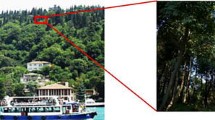Abstract
93 black & white panchromatic aerial photographs of 1972 on 1:20,000 scale were used for assessing the site quality of Sal forest of part of West Dehradun Forest Division, by both direct and indirect methods. The forests were stratified into 5 height and 5 density classes and according to species composition. For necessary data for the assessment of growing stock, field measurements were made on 54 sample plots of 0.1 hectare each. This provided direct indication of actual productive capacity of a particular site. According to indirect method, ground vegetation was sampled in 54 quadrats of 5m x 5m each and has been classified into statistically sound vegetation groupings by normal association analysis technique. These groups facilitated the standardisation of their photo perameters. The indicator value of the plants in a grouping was used to assess the suitability of the site. This was substantiated by super-imposing growing stock, present at that site. By combination of the direct and indirect methods, sites have been classified into 3 categories i.e., suitable, conditionally suitable and unsuitable. Suggestions have been made for management of conditionally suitable sites and the cause for unsuitability of sites are explored. Hence, interpretation of qualitative attributes of vegetation alongwith the measurements of quantitative parameters on aerial photographs have proved to be useful for site quality assessment.
Similar content being viewed by others
References
Anonymous, 1970. Growth and yield statistics of common Indian timber species (Plains region). 328p. Forest Research Institute and Colleges, Dehradun.
Burger, D. 1972. Forest site classification in Canada. Mitt. Ver. fur Forstl. Standorstakunde u. Forstpflanzenzuchtung 21. 20–36.
Champion, H.G. and seth, S.K. 1968. a revised survey of forest types of India. 404p. Govt. of India Publications, Delhi.
Ellenberg, H. 1967. Ecological and pedological methods of forest site mapping (in Germna, Ebglish summaries). Veroffentl. geobot. Inst. ETH. Stiftg. Rubel, Zurich, No.39. 298p. Including six maps at 1:10,000.
Gupta, B.L. 1969. Forest flora of the Chakrata, Dehradun and Saharanpur forest division, Uttar Pradesh. Fourth Reprint. 593p. Govt. of India Publications, Delhi.
Khan, M.A.W. 1962. Methods of studying forest types. Indian For. 88(2): 109–114.
Kuchler, a.W. 1967. Vegetation mapping. The Ronald Press Company, New York.
Kumar, S., Singh, G. and Gogoi, L.C. 1980. Report on Forest type and vegetation mapping, assessment of growing stock and area estimation of Part of Timli Forest Range (West Dehradun Division). 47p. Indian Photo-Interpretation Institute, NRSA, Dehradun.
Lai, S. 1978. the Time of India Directory and Year Book including Who’s Who. The Times of India Press, Bombay. 960p.
Mueller-DomboicD. 1965a. Eco-geographic criteria for mapping forest habitats in southeastern Manitoba. Forestry Chronicle (Vancouver, B.C.) 41 188–206.
Muller-Dombois, D. and Ellenberg, H. 1974. Aims and methods of vegetation ecology. 547p. John Wiley and Sons Inc., New York
Rennie, P.J. 1963. Methods of assessing sitle capacity. Commonwealth forestry Review 42(4): 306–317.
Sagreiya, K.P. 1967. Forests and Forestry. National Book Trust, India, New Delhi. 218p.
Shedha, M.D. 1979a. Fundamentals of Photo-interpretation and qualitative photo-interpretation in forestry (Mimeo) I.P.I. Notes. 127p.
Shedha, M.D. 1979b. Measurements and estimation in forestry from aerial photographs (Mimeo). IPI Notes. 61p.
Smyth, A.J. 1974. Development of international standards of land classification, p. 12–22.in Land Capability Classification. Technical Bulletin 30. Ministry of Agriculture, Fisheries and Food. Her Majesty’s Stationery Office, London.
Toleman, R.D.L. 1974. Land Capability Classification in the Forestry Commission, p.97–108.In Land Capability Classification. Technical Bulletin 30. Ministry of Agriculture, Fisheries and Food. Her Majesty’s Stationery Officke, London.
Williams, W.T. and Lambert, J.M. 1959. Multivariate methods in plant ecology: I Association analysis in plant communities J. Ecol. 47: 83–101.
Author information
Authors and Affiliations
About this article
Cite this article
Shedha, M.D., Kumar, S. Forest site quality assessment by aerial photo-interpretation case study of sal forests. Journ. Ind. Soc. Photo-Int. & Remote Sensing 12, 13–25 (1984). https://doi.org/10.1007/BF02991432
Issue Date:
DOI: https://doi.org/10.1007/BF02991432




